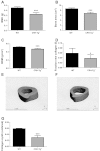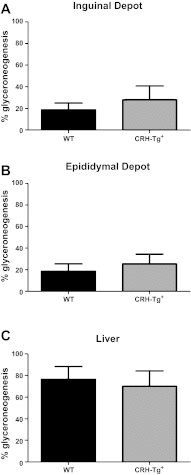Large increases in adipose triacylglycerol flux in Cushingoid CRH-Tg mice are explained by futile cycling
- PMID: 23211515
- PMCID: PMC3566431
- DOI: 10.1152/ajpendo.00154.2012
Large increases in adipose triacylglycerol flux in Cushingoid CRH-Tg mice are explained by futile cycling
Abstract
Glucocorticoids are extremely effective anti-inflammatory therapies, but their clinical use is limited due to severe side effects, including osteoporosis, muscle wasting, fat redistribution, and skin thinning. Here we use heavy water labeling and mass spectrometry to measure fluxes through metabolic pathways impacted by glucocorticoids. We combine these methods with measurements of body composition in corticotropin-releasing hormone (CRH)-transgenic (Tg)(+) mice that have chronically elevated, endogenously produced corticosterone and a phenotype that closely mimics Cushing's disease in humans. CRH-Tg(+) mice had increased adipose mass, adipose triglyceride synthesis, and greatly increased triglyceride/fatty acid cycling in subcutaneous and abdominal fat depots and increased de novo lipogenesis in the abdominal depot. In bone, CRH-Tg(+) mice had decreased bone mass, absolute collagen synthesis rates, and collagen breakdown rate. In skin, CRH-Tg(+) mice had decreased skin thickness and absolute collagen synthesis rates but no decrease in the collagen breakdown rate. In muscle, CRH-Tg(+) mice had decreased muscle mass and absolute protein synthesis but no decrease in the protein breakdown rate. We conclude that chronic exposure to endogenous glucocorticoid excess in mice is associated with ongoing decreases in bone collagen, skin collagen, and muscle protein synthesis without compensatory reduction (coupling) of breakdown rates in skin and muscle. Both of these actions contribute to reduced protein pool sizes. We also conclude that increased cycling between triglycerides and free fatty acids occurs in both abdominal and subcutaneous fat depots in CRH-Tg(+) mice. CRH-Tg mice have both increased lipolysis and increased triglyceride synthesis in adipose tissue.
Figures






Similar articles
-
The CRH-Transgenic Cushingoid Mouse Is a Model of Glucocorticoid-Induced Osteoporosis.JBMR Plus. 2017 Jun 28;1(1):46-57. doi: 10.1002/jbm4.10009. eCollection 2017 Aug. JBMR Plus. 2017. PMID: 30283880 Free PMC article.
-
Corticotropin-releasing hormone (CRH) transgenic mice display hyperphagia with increased Agouti-related protein mRNA in the hypothalamic arcuate nucleus.Endocr J. 2011;58(4):279-86. doi: 10.1507/endocrj.k10e-370. Epub 2011 Mar 5. Endocr J. 2011. PMID: 21389639
-
Dexamethasone-mediated changes in adipose triacylglycerol metabolism are exaggerated, not diminished, in the absence of a functional GR dimerization domain.Endocrinology. 2013 Apr;154(4):1528-39. doi: 10.1210/en.2011-1047. Epub 2013 Mar 14. Endocrinology. 2013. PMID: 23493372 Free PMC article.
-
Cushing’s disease and melancholia.Stress. 2001 Jun;4(2):91-119. doi: 10.3109/10253890109115725. Stress. 2001. PMID: 22432130 Review.
-
Ectopic production of ACTH and corticotropin-releasing hormone (CRH).J Steroid Biochem Mol Biol. 1992 Oct;43(5):403-8. doi: 10.1016/0960-0760(92)90076-u. J Steroid Biochem Mol Biol. 1992. PMID: 1327073 Review.
Cited by
-
Glucocorticoid Receptor and Adipocyte Biology.Nucl Receptor Res. 2018;5:101373. doi: 10.32527/2018/101373. Nucl Receptor Res. 2018. PMID: 30310815 Free PMC article.
-
The glucocorticoid-Angptl4-ceramide axis induces insulin resistance through PP2A and PKCζ.Sci Signal. 2017 Jul 25;10(489):eaai7905. doi: 10.1126/scisignal.aai7905. Sci Signal. 2017. PMID: 28743803 Free PMC article.
-
Fresh insights into glucocorticoid-induced diabetes mellitus and new therapeutic directions.Nat Rev Endocrinol. 2022 Sep;18(9):540-557. doi: 10.1038/s41574-022-00683-6. Epub 2022 May 18. Nat Rev Endocrinol. 2022. PMID: 35585199 Free PMC article. Review.
-
Deconstructing the roles of glucocorticoids in adipose tissue biology and the development of central obesity.Biochim Biophys Acta. 2014 Mar;1842(3):473-81. doi: 10.1016/j.bbadis.2013.05.029. Epub 2013 Jun 2. Biochim Biophys Acta. 2014. PMID: 23735216 Free PMC article. Review.
-
The CRH-Transgenic Cushingoid Mouse Is a Model of Glucocorticoid-Induced Osteoporosis.JBMR Plus. 2017 Jun 28;1(1):46-57. doi: 10.1002/jbm4.10009. eCollection 2017 Aug. JBMR Plus. 2017. PMID: 30283880 Free PMC article.
References
-
- Autio P, Oikarinen A, Melkko J, Risteli J, Risteli L. Systemic glucocorticoids decrease the synthesis of type I and type III collagen in human skin in vivo, whereas isotretinoin treatment has little effect. Br J Dermatol 131: 660– 663, 1994 - PubMed
-
- Besser GM, Edwards CRW. Cushing's syndrome. Clin Endocrinol Metab 1: 451– 490, 1972
-
- Bujalska IJ, Kumar S, Stewart PM. Does central obesity reflect “Cushing's disease of the omentum”? Lancet 349: 1210– 1213, 1997 - PubMed
-
- Busch R, Kim YK, Neese RA, Schade-Serin V, Collins M, Awada M, Gardner JL, Beysen C, Marino ME, Misell LM, Hellerstein MK. Measurement of protein turnover rates by heavy water labeling of nonessential amino acids. Biochim Biophys Acta 1760: 730– 744, 2006 - PubMed
Publication types
MeSH terms
Substances
Grants and funding
LinkOut - more resources
Full Text Sources
Other Literature Sources
Molecular Biology Databases
Miscellaneous

